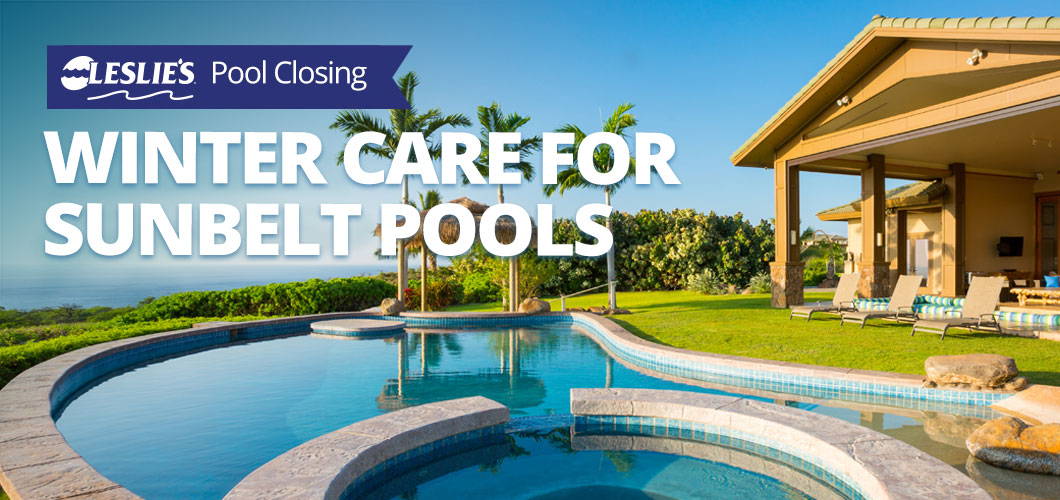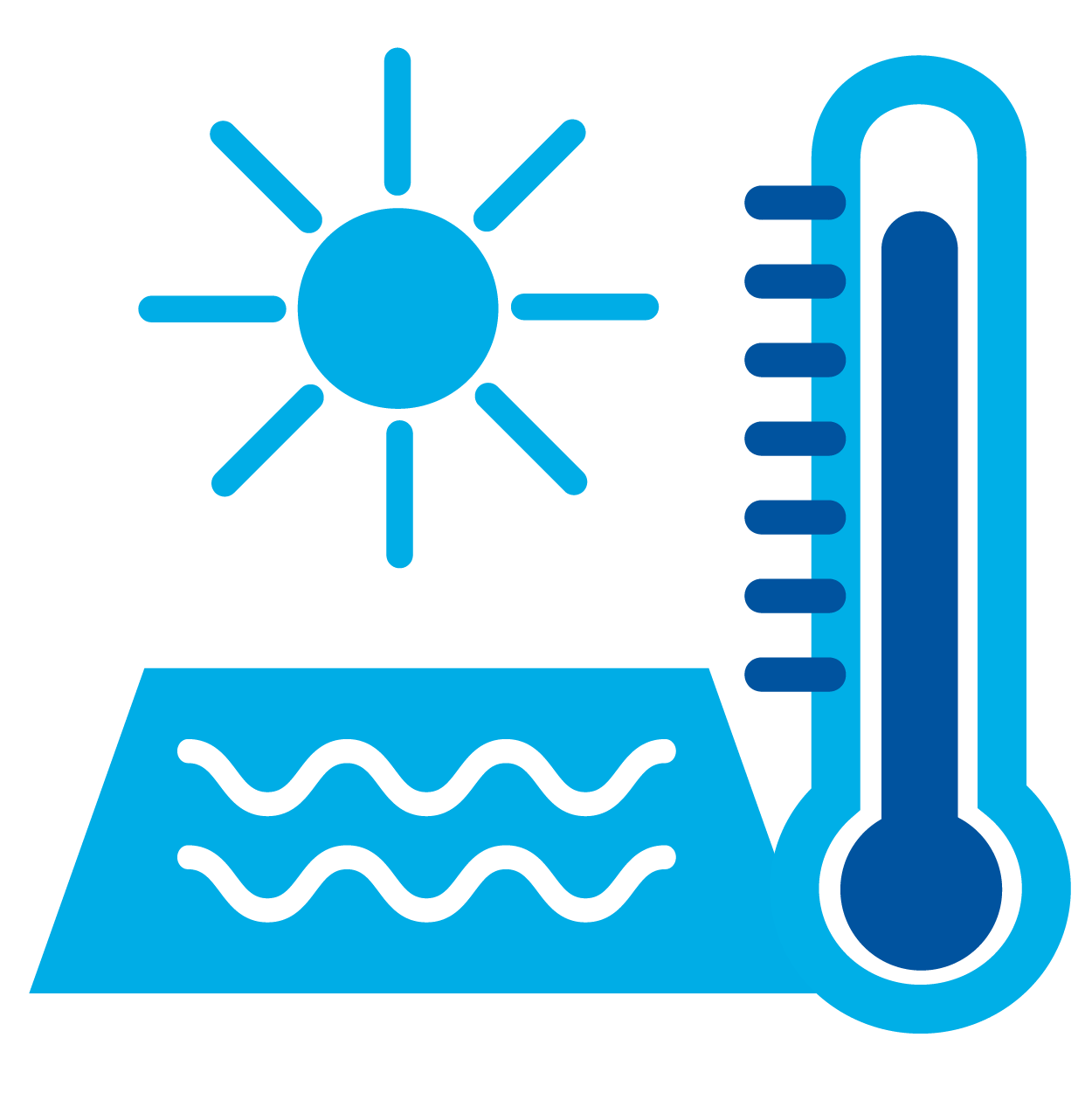
Winter Care for Sunbelt Pools
If you’re lucky enough to live in an area that sees very few (if any) days of freezing temperatures during the winter, then this article is for you! Unlike pool owners in the snowbelt, who have to fully winterize their pools in the fall to avoid freeze damage, pool owners in the southern United States have a few different options for maintaining their pools through the cooler off-season months. You may not even need to close your pool at all! Pool owners in warm climates, also known as the sunbelt, have three choices for pool care through the winter:

Full Pool Closure

Partial Pool Closure

No Pool Closure
Each type of pool closure has its own set of pros and cons. Today, we’ll navigate the ins and outs to help you decide which method works best for your pool and lifestyle. We’ll also walk you through a few helpful winter pool care tips for each closing option.
WARNING: No matter what you decide to do with your pool this winter, unexpected freezing conditions can wreak havoc on an unwinterized or improperly closed pool. When freezing weather and severe winter storms are in the forecast, always have a backup plan. Automatic freeze protection is a must-have if you're leaving your equipment connected. However, if the power goes out, you need to act quickly to prevent freeze damage from ruining your pool equipment and plumbing. You can find more information about winter storm response and recovery in our other blog posts:
Pool Recovery After a Winter Storm
How to Respond to Freezing Weather Conditions in Your Pool
How to Maintain a Pool With Damaged Equipment
Full Pool Closure
This type of pool closing is the most common. As the name suggests, a full or complete pool closure involves a hard shutdown and winterization of the pool system through the cooler fall and winter months. Most pools in the snowbelt fully close their pools during the off-season, and it’s a popular option for sunbelt pool owners who prefer a low-maintenance pool care approach during winter. A full pool closure typically involves the following steps:
- Thoroughly clean the pool with a brush, rake, and vacuum.
- Balance the water and add pool closing chemicals.
- Turn off power to the pool. Drain all pool equipment, including pump, filter, and pool cleaner. Where appropriate, disconnect the equipment and store it out of the elements.
- Lower the water level below the skimmer.
- Blow out the pool lines and add pool antifreeze to the plumbing. Add winter plugs and Gizzmos.
- Remove ladders and other accessories in or around the pool area.
- Cover the pool.
Pros of a Full Pool Closure
In many cases, a full pool closure requires the least amount of time and maintenance through the winter. With everything closed off and the pool under cover, you won’t be investing as much money on chemicals, and you’ll also save quite a bit on your monthly energy bill.
Cons of a Full Pool Closure
The warmer the water, the harder it is to keep algae in check. Areas that maintain a daily temperature average of 65+ degrees Fahrenheit through the winter may want to consider other options for pool closure, because the winter chemicals added at closing time may get used up too quickly. Pools that are fully closed for the duration of the winter may take a couple days to open back up in the spring, depending on the condition of the water once the cover is removed.
DIY TIP: Particularly in the sunbelt states, it is important to check water balance and make sure there’s still enough sanitizer in the water to ward off algae. Covered pools can also conceal water leaks, which can become a problem if left unchecked. Take a peek under the cover every 2–4 weeks to check water levels and collect a water sample. The colder the water, the less frequently you’ll need to test.
Partial Pool Closure
Many sunbelt pool owners opt for a partial pool closure, also called a soft pool closing. Although not as intensive as a full closure, it requires ongoing maintenance. Even so, the reduced weekly pool care is appealing for sunbelt residents who still want a break from their pools this winter. Steps are similar to a full closure, but with a few key differences. With a partial closing, you won’t have to worry about lowering the water level, draining the equipment, or even winterizing the plumbing. You can partially close a pool with these simple steps:
- Thoroughly clean the pool with a brush, rake, and vacuum.
- Balance the water and add chemicals as necessary. Add stain prevention, algaecide, and shock, just like you would for a full closing.
- Make sure the filter, pump basket, and skimmer basket are clean and free of debris.
- Remove and winterize any equipment, accessories, or water features that won’t be needed during the winter. This includes cleaners, booster pumps, and sometimes salt chlorinators and heaters.
That’s it! Pool covers are completely optional with partially closed pools, but they help keep debris out and reduce evaporation. Continue pool maintenance as you normally would, maintaining water balance and sanitizer levels through the off-season. Test the water, rebalance, and add sanitizer as needed every 2–3 weeks. For a more accurate and comprehensive water chemistry analysis, bring a water sample to your local Leslie's for a FREE AccuBlue® water test.
You’ll only need to run the pump for a few hours a day if temperatures are below 60ºF. If freezing temperatures are in the forecast, run the pump continuously until the temps return to a safe level. Freeze sensors automatically turn on the pump whenever temps dip below a certain point, so they’re a popular accessory for partial pool closings.
Pros of a Partial Pool Closure
The amount of time and money spent on pool maintenance is much less than if you leave the pool open all winter. You’ll be able to enjoy some “time off” away from the pool, but you won’t have to go through the intensive routine of a full pool closure. Partially closed pools are extremely easy to reopen and require minimum effort on opening day.
Cons of a Partial Pool Closure
Although much less than an open pool, a partially closed pool still requires some amount of time and attentive management. You must take precautions to avoid freeze damage in case the temperatures drop suddenly. Automatic freeze protection is invaluable in these scenarios.
PRO TIP: If you have a saltwater pool, you may want to remove, winterize, and store the cell to avoid damage. Some salt chlorinators even have a neutral or winterize mode you can use instead, or they offer a dummy cell to install in its place. Salt chlorine generators don’t produce chlorine efficiently in cool temperatures, causing them to work harder and wear out faster. It’s best to switch to another chlorine source during the winter months.
No Pool Closure
Just because it’s winter in the sunbelt doesn’t mean the pool has to close! With the help of a pool heater or heat pump, your pool can remain open and comfortably swimmable year-round. This option is particularly appealing for pool owners in the warmest parts of the sunbelt, who see daily high temperatures in the upper 70s or higher for most of the winter — a more ideal temperature for routine pool care.
Pros of No Pool Closure
You can enjoy the benefits of your pool all year long! In the warmest climates, an on-demand pool heater or heat pump can help you comfortably enjoy the benefits of your pool whenever you're craving a swim day.
Cons of No Pool Closure
You won’t save time on maintenance, and you won’t be saving money on energy, water, or chemical expenses. Depending on the type of heater and frequency of use, it may actually cost more money each month. Much like with a partial closure, you'll have to make sure the pool doesn’t suffer freeze damage if temperatures fall suddenly or unexpectedly.
DIY TIP: If you’re using a pool heater or heat pump to warm the water, a solar pool cover will help keep the generated heat in the pool. Solar covers insulate the water’s surface and reduce the rate of evaporation, which is the primary source of heat loss. On a warm, sunny day, a solar cover can also supplement your pool heater by trapping warmth from the sun’s powerful rays. A solar cover is one of the few pool investments you can make that will pay for itself in water, chemical, and energy savings.
No matter which type of pool closure you decide is best for your sunbelt pool, Leslie's has you covered. From pool closing chemicals and accessories, to winter covers and cover pumps, we have what you need to keep your pool healthy through the winter months. Stop by your local Leslie's to pick up your winter essentials and get helpful pool closing tips. You can also check out our extensive online selection of pool supplies.